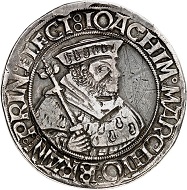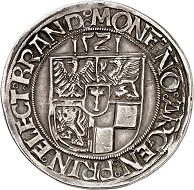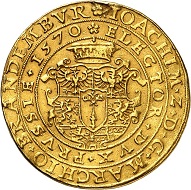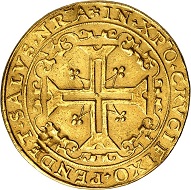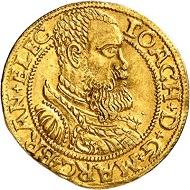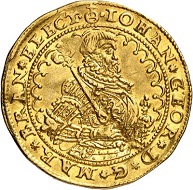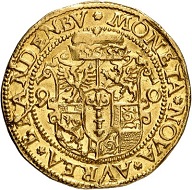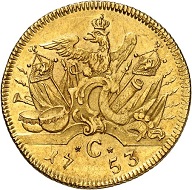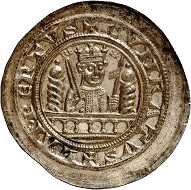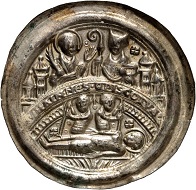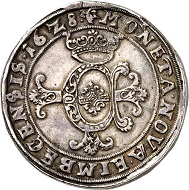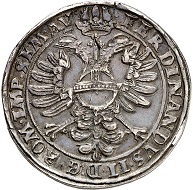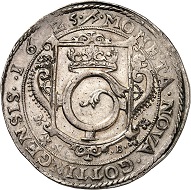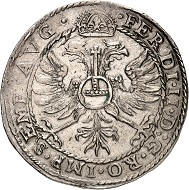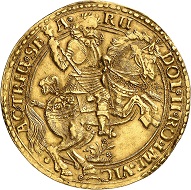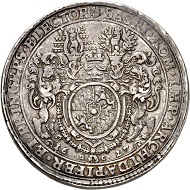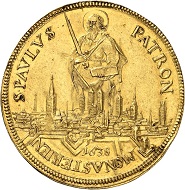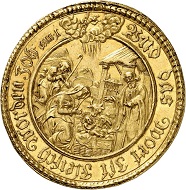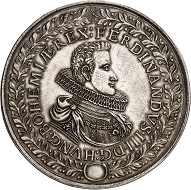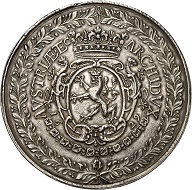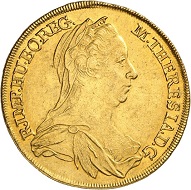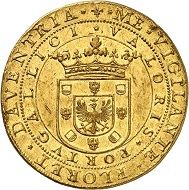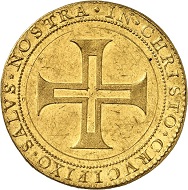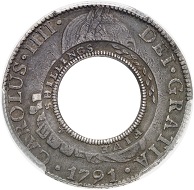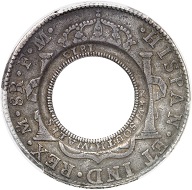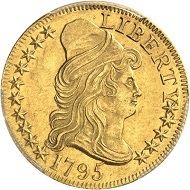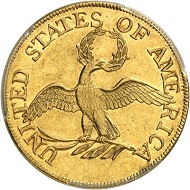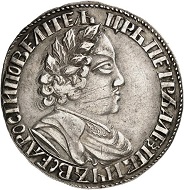31-01-2018 – 01-01-1970
Auctions 300-302
The Künker Berlin-auctions: 10 millions for 1,113 lots
It was quite an experience, seeing the many bidders who insisted on personally attending the Berlin-auctions of Künker. Their active bidding was responsible for a great delay in schedule. The first collection, the Gunther Hahn collection, with coins and medals from Brandenburg-Prussia already doubled its estimate, but it also took double the estimated time to auction it.
And that was only the start. The 1,113 lots attained close to 10 m. euros, while the original estimate was at 6 m. euros. But this also meant that bidders had to wait until 11 pm, if they wanted to bid for the last lots.
Los 2: Brandenburg-Prussia. Joachim I, 1499-1535. Taler 1521, Frankfurt / Oder. Extremely rare. Very fine. Estimate: 30,000.- euros. Hammer price: 70,000 euros.
Auction 300: Standout objects of Brandenburg-Prussia – the Gunther Hahn collection
Auction 300 consisted of 216 lots, which featured the Gunther Hahn collection with coins and medals from Brandenburg-Prussia. The collection entailed true highlights from the early times of the March, but also numerous coins from the time of Frederick the Great. The collectors were delighted and offered high bids. There was the first Brandenburg taler in very fine. The specimen, whose provenance dates back to 1877, climbed up to 70,000 euros from the estimated 30,000.
Los 7: Brandenburg-Prussia. Joachim II, 1535-1571. Portugaleser of 10 ducats 1570, Berlin. Extremely rare. Very fine. Estimate: 200,000 euros. Hammer price: 180,000 euros.
The most expensive piece of the collection, the portugaleser of Joachim II from 1570, stayed slightly below its estimate. It was closely tied to the trial of his successor John George against the court factor of his father, Lipman ben Juda. Estimated at 200,000 euros, it went for 180,000 euros.
8: Brandenburg-Prussia. Joachim II, 1535-1571. Ducat 1560, Berlin. Almost extremely fine. Estimate: 60,000 euros. Hammer price: 100.000 euros.
The first ducat of Brandenburg, featuring an Elector’s portrait, namely the portrait of Joachim II, was sold for 100,000 euros after an estimate of 60,000 euros.
12: Brandenburg-Prussia. Johann Georg, 1571-1598. Ducat 1590, Berlin. Extremely rare. Extremely fine. Estimate: 25,000 euros. Hammer price: 55,000 euros.
And a ducat of his son John George rose from 25,000 euros to 55,000 euros.
92: Brandenburg-Prussia. Frederick II the Great, 1740-1786. Double Friedrichs d’or 1753, Cleve. Extremely rare. Extremely fine. Estimate: 25,000 euros. Hammer price: 55,000 euros.
Let’s take a look at the era of King Frederick the Great. An extremely rare double Friedrichs d’or from 1753 from Cleve in extremely fine was bought for more than double the amount of its original estimate. Incidentally, there were also some very interesting coins which were truly affordable for everyone. A very fine 6 gröscher from 1757, a typical example of the coins, Frederick used to finance the Seven Year’s War, for instance barely met its estimate of 25 euros.
502: Mühlhausen. Conrad III, 1138-1152. Bracteate. Extremely rare. Almost FDC. Estimate: 25,000 euros. Hammer price: 36,000 euros.
Auction 301: Selected bracteates from the Professor Helmut Hahn collection / 150 rarities from Lower Saxony from the Friedrich Popken collection
Medieval bracteates can get quite expensive, too. This was demonstrated by the Professor Helmut Hahn collection featuring the most beautiful objects you will find in this field of interest. The prices were accordingly high. A coin that was already the most expensive bracteate in history more than 30 years ago with a hammer price of 40,000 DM, became the most expensive item of this collection, too. The bracteate of Konrad III from Mühlhausen changed its owner in the year 2018 for 36,000 euros.
560: Magdeburg. Friedrich I von Wettin, 1142-1152. Bracteate ca. 1150, Halle. Very rare. Extremely fine. Estimate: 4,800 euros. Hammer price: 17,000 euros.
A bracteate from John I of Merseburg was almost as expensive. It shows a scene with many characters: The field in the lower half shows two torturers agonising Saint Lawrence. The field in the upper half contains two busts of bishop and saint in urban scenery. Both scenes are separated by a banner featuring the name and title of the minting authority. A collector was willing to pay 30,000 euros for this highly interesting piece. 26,000 euros were paid for a bracteate of Burkhard II von Falkenstein, minted in Ermsleben, 22,000 euros for a bracteate by the abess Cäcilia von Nordhausen and 17,000 euros for a bracteate of Friedrich I von Wettin, minted with the image of Saint Maurice around 1150 in Halle.
777: Einbeck. Double taler 1628. 2nd known specimen. Almost extremely fine. Estimate: 30,000 euros. Hammer price: 65,000 euros.
It was actually anticipated that some of the 150 rarities from Lower Saxony from the Friedrich Popken collection would reach extremely high prices. A double taler from the city of Einbeck of 1628, with only one other known specimen, was sold for 65,000 euros instead of 30,000 euros as estimated.
781: Göttingen. Taler 1625. Extremely rare. Extremely fine. Estimate: 20,000 euros. Hammer price: 60,000 euros.
A taler from the year 1625 from Göttingen, also of utmost rarity from the Walter Rollas du Rosey collection, climbed from 20,000 to 60,000 euros. A mule double taler from the city of Hameln, which states the year 1616 on the obverse and the year 1617 on the reverse, was bought for 75,000 euros instead of 30,000 euros. A gold strike of the weight of five gold gulden from the dies of a reichstaler without date, issued by order of Ferdinand von Bayern between 1615 and 1617 reached double the price of its estimate, 60,000 euros.
865: Hildesheim / City. Gold donative in the weight of 10 ducats no date (after 1618). Very rare. Very fine to extremely fine. Estimate: 50,000 euros. Hammer price: 120,000 euros.
Another gold donative at the weight of 10 ducats, this time from the city of Hildesheim, was minted after 1618. This precious coin, which shows the emperor Rudolf as field commander on a rearing horse on the reverse, was sold for an impressive 120,000 euros instead of the estimated 50,000 euros.
1028: Bavaria. Maximilian I, 1598-1651. Double reichstaler 1627, Heidelberg, for the Rhenish Palatinate. Very fine to extremely fine. Estimate: 40,000 euros. Hammer price: 80,000 euros.
Auction 302: Numismatic rarities from around the world / Russian coins and medals
Künker’s third auction from February 1, 2018 was titled ‘Rarities from around the world’ and the results matched this title. One double reichstaler by the Bavarian elector Maximilian I, minted 1627 in Heidelberg for the Rhenish Palatinate was sold for 80,000 euros, which was twice as much as the estimate.
1134: Münster. Ferdinand of Bavaria, 1612-1650. 5 ducats 1638, Münster. Extremely rare. Extremely fine. Estimate: 50,000 euros. Hammer price: 80,000 euros.
A 5 ducat coin by Ferdinand of Bavaria for the bishopric of Münster from the year 1638 with an idyllic Nativity scene reached the same hammer price.
1271: Holy Roman Empire. Ferdinand III., 1625-1637-1657. Sixfold reichstaler 1629, Prague. Extremely fine. Estimate: 20,000 euros. Hammer price: 110,000 euros.
The results of the 100 lots from the Holy Roman Empire were particularly impressive. Was it the jubilee of Maria Theresa which heated this field of collecting so much? In any case, rare coins from the Habsburg Dynasty reached record prices during the last months. 110,000 euros was the last bid for a sixfold reichstaler from 1629 which shows the portrait of Ferdinand III on the obverse. This possibly unique specimen had been estimated at 20,000 euros. A heavy gold coin at the weight of 10 ducats on the seizure of Buda under Leopold I in the year 1686 was auctioned for 45,000 euros.
1318: Holy Roman Empire. Maria Theresa, 1740-1780. 4 ducats 1778, Vienna. Possibly only known specimen. Estimate: 25,000 euros. Hammer price: 120,000 euros.
But the coins of Maria Teresa were the true surprise of the auction. There were 23 objects on offer. Their estimate was 47,000 euros. The final result added up to an incredible 285,000 euros. The six coins from the Prague mint were the main reason for this high sum. They had been estimated at a total of 13,200 euros and sold for 128,000 (!) euros. The second reason for the astonishing result of the Austrian ruler’s coins was a unique specimen: A 4-fold ducat from 1778 from Vienna, estimated at 25,000 euros, which realised 120,000 euros. Let’s also mention a 12-fold ducat from 1687 from Salzburg. This very attractive coin of the archbishop Johann Ernst von Thun und Hohenstein climbed from 50,000 to 70,000 euros.
1425: Netherlands. Deventer / City. Portugaleser of 10 ducats no date (1640). Extremely fine+. Estimate: 200,000 euros. Hammer price: 240,000 euros.
The most expensive item of the auction was sold with a hammer price of 240,000 euros – a portugaleser at 10 ducats from 1640 from the city Deventer.
1468: Australia. New South Wales. 5 shillings (holey dollar) 1813. Struck on an 8 reales 1791 from Mexico, Charles III, 1788-1808, Mexico City. Extremely rare. PCGS graded VG 35. Coin: very fine+. Counter mark: almost extremely fine. Estimate: 100,000 euros. Hammer price: 150,000 euros.
The result for the holey dollar from Australia, which is virtually an icon of Down Under numismatics, was similarly impressive. It was auctioned for 150,000 euros. The dump, which is the part of the holey dollar that was punched out, was cheaper. It realised 40,000 euros.
1483: USA. Federation. 5 dollars 1795, Philadelphia. Very rare. PCGS graded MS 61. Extremely fine. Estimate: 35,000 euros. Hammer price: 55,000 euros.
The early coins from the United States of America had remarkable results, too. A 5 dollar coin from 1795 with the grade PCGS MS61 attained 55,000 euros – the same amount as a 10 dollar ‘Indian’ from 1907 graded PCGS MS65.
1534: Russia. Peter I, the Great, 1682-1725. 1/2 roubel (polupoltinnik) 1702 (Cyrillic), Moscow, Kadashevsky Mint. Very rare. Very fine to extremely fine. Estimate: 40,000 euros. Hammer price: 46,000 euros.
Let’s end with a glance at the Russian coins. A 1/2 rouble 1702 of Peter I, the Great from the Moscow Kadashevsky mint had been estimated at 40,000 euros and it was sold for 46,000 euros. A 10 rouble coin by the czarina Elisabeth, minted in 1756 in St. Petersburg, graded PCGS MS 61 was estimated at 30,000 euros and auctioned for 44,000 euros.
This is the Künker website.
Any information around the Künker Berlin-auctions can be found in Künker’s auction archive.




